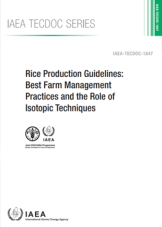Increasing global temperatures and changes in climate have major impacts on agriculture, affecting ecosystems and the benefits they provide to society. Crop and livestock production, agricultural soil and water resources, and food security are increasingly affected. Nuclear and isotopic techniques are crucial for assessing the impacts of climate change.
The effects of climate change are expected to worsen, bringing more extreme weather events such as droughts, floods, heat waves and unpredictable rainfall distribution, all of which threaten food security and could make agricultural production difficult, if not impossible. This could be further exacerbated by the accelerated release of greenhouse gases into the atmosphere from soil leading to global warming. Already fragile ecosystems would be affected, causing severe land degradation and further endangering food security.
To assess the impact of such climatic changes, it is important to obtain the vital information that allows for modelling and predicting future climate trends. Together with the FAO, the IAEA aims to optimise and strengthen the capacities of Member States in using nuclear and isotopic techniques to learn more about and assess the impacts of climate change, supporting intensified crop production and the preservation of natural resources.
How nuclear and isotopic techniques contribute
Climate change will have a major impact on livestock farming and food production from animals. To address this, continued research is needed to develop the necessary tools and guidelines that can help optimise and harmonize agricultural practices.
One technique to assess the impact of climate change on soil degradation and sediment redistribution involves the use of fallout radionuclides. Another is the compound-specific stable isotope analysis, with which researchers can identify sources of land degradation and develop effective soil conservation measures.
The carbon-13 isotope technique is used to quantify the turn-over of soil organic matter under different climate change scenarios. With the nitrogen-15 technique, sources of nitrous oxide production from farmlands can be identified, an important step to design appropriate mitigation strategies that help minimize greenhouse gas emissions. To determine the proportion of water agricultural management practices lose as a result of soil evaporation and plant transpiration, the oxygen-18 isotopic signature in water vapour can be used.
To trace animal movements, and thereby assess more efficiently the risks of disease transmission, stable isotope ratios are measured. Finally, the combination of long chain hydrocarbon and natural carbon-13 on plants eaten by animals and in their faeces helps estimate their intake under diverse feeding conditions, which in turn provides information for better feed supplementation strategies.
Other nuclear and isotopic techniques are used to indicate whether climate-smart agricultural practices have been applied. This includes the use of carbon-14 and tritium labelled compounds as radioactive tracers; radio immune and radio receptor assays (investigative methods used in such areas as laboratory medicine or environmental biology); isotope dilution analysis to determine the quantity of chemical substances; and liquid or gas chromatography tandem mass spectrometry. These are used to monitor agrochemical inputs, especially residues of pesticides and veterinary drugs, in the environment.





